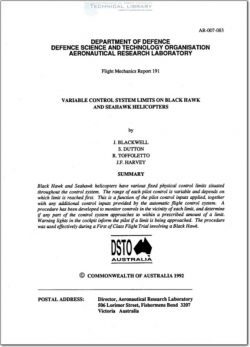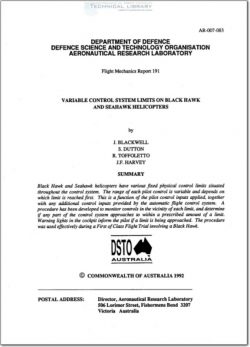DSTO-AR-007-083

- Version
- 61 Downloads
- 1.58 MB File Size
- 1 File Count
- August 10, 2016 Create Date
- August 10, 2016 Last Updated
Variable Control System Limits on Black Hawk and Seahawk Helicopters

The Aircraft Maintenance and Flight Trials Unit (AMAFI‘U) of the Royal Australian Navy
(RAN) conducts a First of Class Flight Trial (FOCFT) for each helicopter/ship combination in
order to establish operational limits. An important requirement of FOCFTs is that the helicopter
controls be instrumented and the pilot be given feedback as to whether any of the controls approach
control limits. In 1990, AMAFI‘U conducted a preliminary trial with a RAN Seahawk helicopter
operating from an FFG-7 frigate. More recently, AMAFI‘U conducted a FOCFT with a Black
Hawk helicopter operating from the Heavy Landing Ship HMAS Tobruk (Ref. 1) and plans to
conduct a FOCFI‘ with a Seahawk operating from an FFG-7.
Black Hawk and Seahawk helicopters have a highly complex control system which includes
mechanical mixing between controls to reduce pilot workload by coupling various controls to
account for coupled responses to given control inputs, and an Automatic Flight Control System
(AFCS) which enhances the stability and control characteristics of the helicopter. The AFCS
provides additional control inputs which are a function of helicopter accelerations, attitudes,
angular rates, and velocities. Details on the control system can be found in Ref. 2.
There are physical end stops in the control system which limit control movement. They are
located between the pilot controls and the mixer unit (four secondary end stops), and between the
mixer unit and the rotor blades (four primary end stops). The range of each pilot control is
variable, depending on whether primary or secondary end stops are reached first, which is a
function of the pilot control inputs being applied, together with additional control inputs from the
AFCS.
It is desired to determine the location of controls relative to the various end stops in the
control system, and in particular to determine when the aircraft controls have approached to within
10% of a control limit. It is quite feasible for controls to be more than 10% from secondary end
stops yet within 10% of primary end stops or vice versa. To be confident that no end stops have
been overlooked, instrumentation of controls relative to all eight end stops is required. The four
secondary controls and primary tail and collective controls move linearly relative to fixed end
stops.
| File | Action |
|---|---|
| DSTO-AR-007-083 Variable Control System Limits on Black Hawk and Seahawk Helicopters.pdf | Download |
Comment On This Post